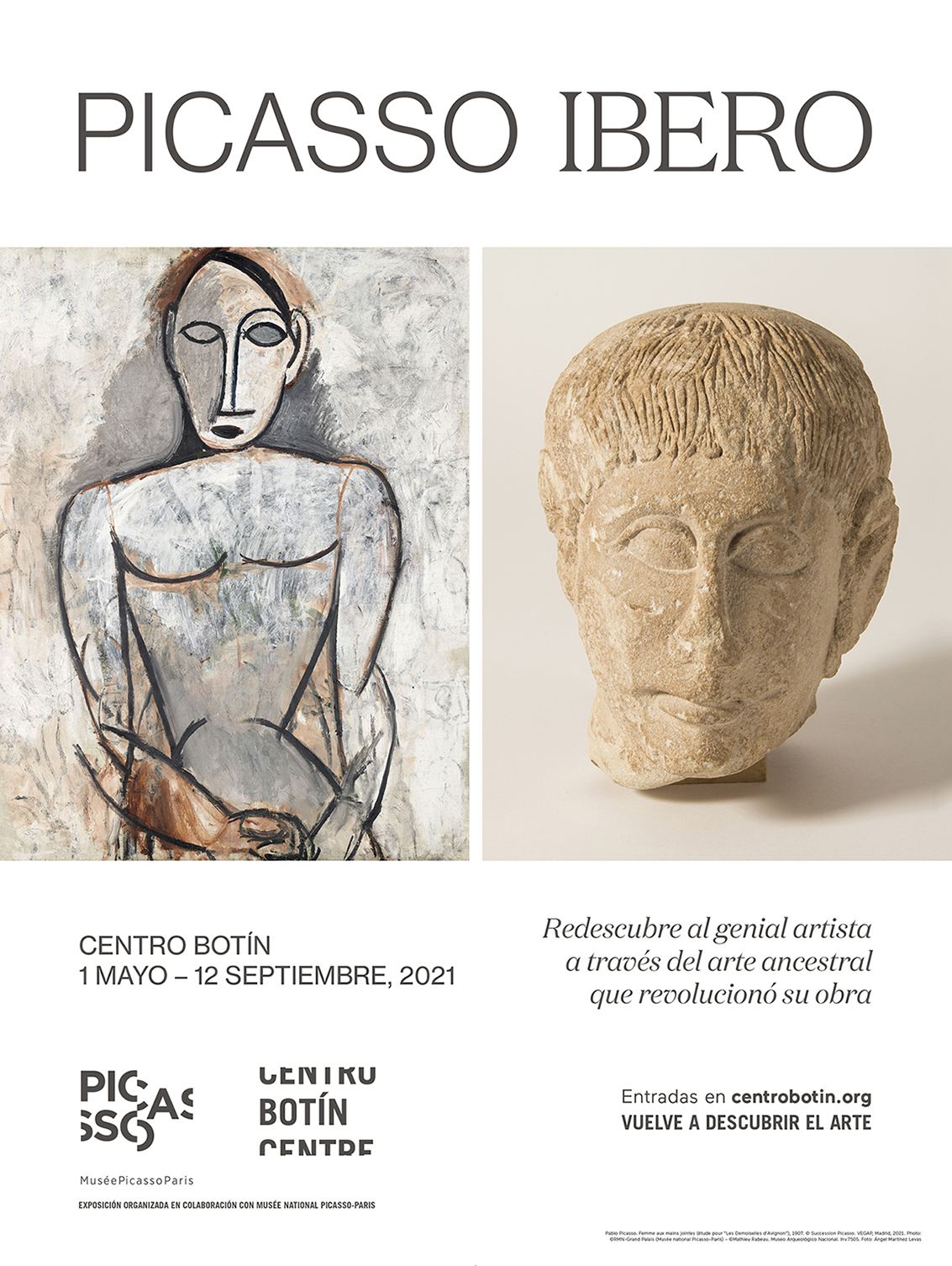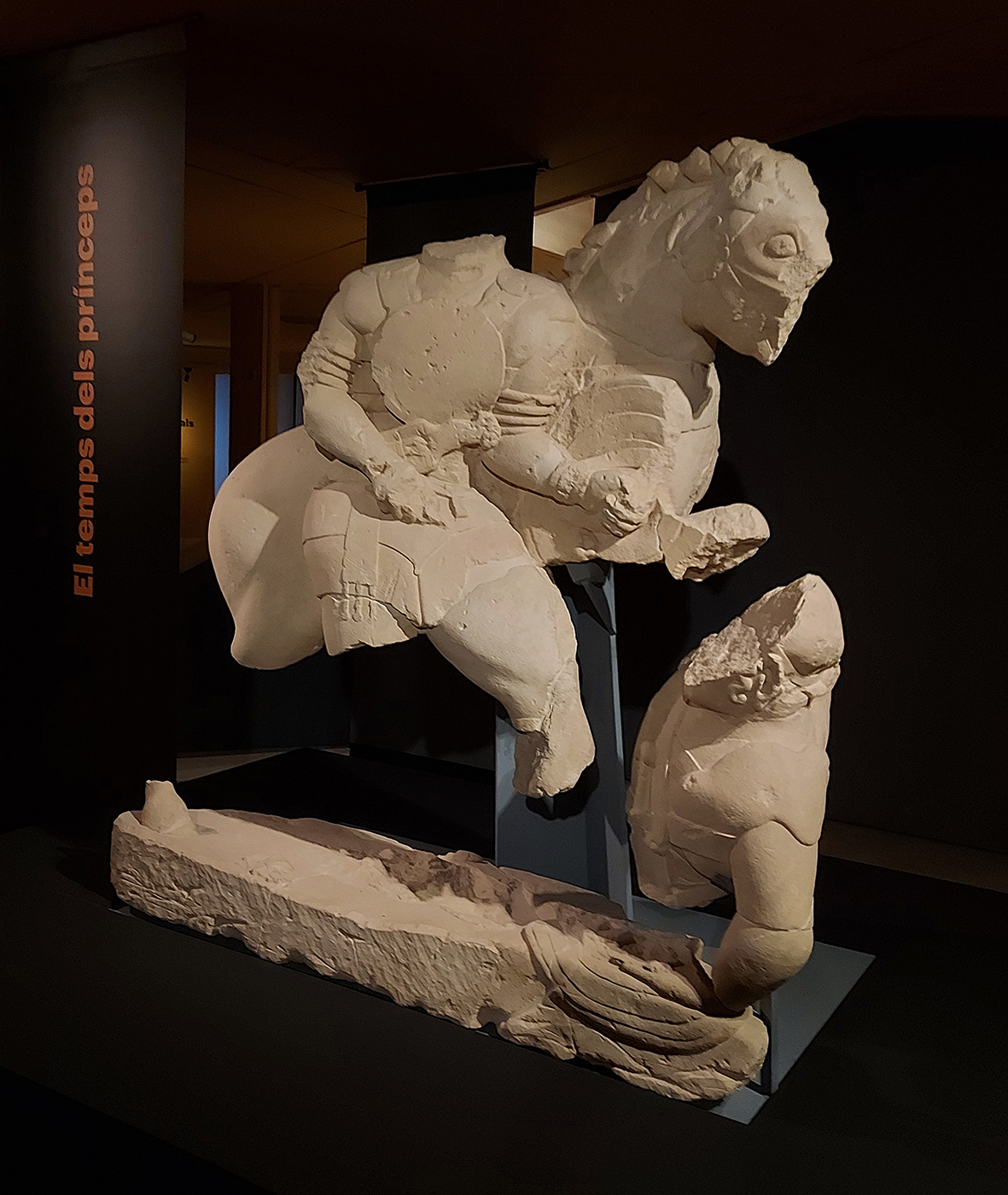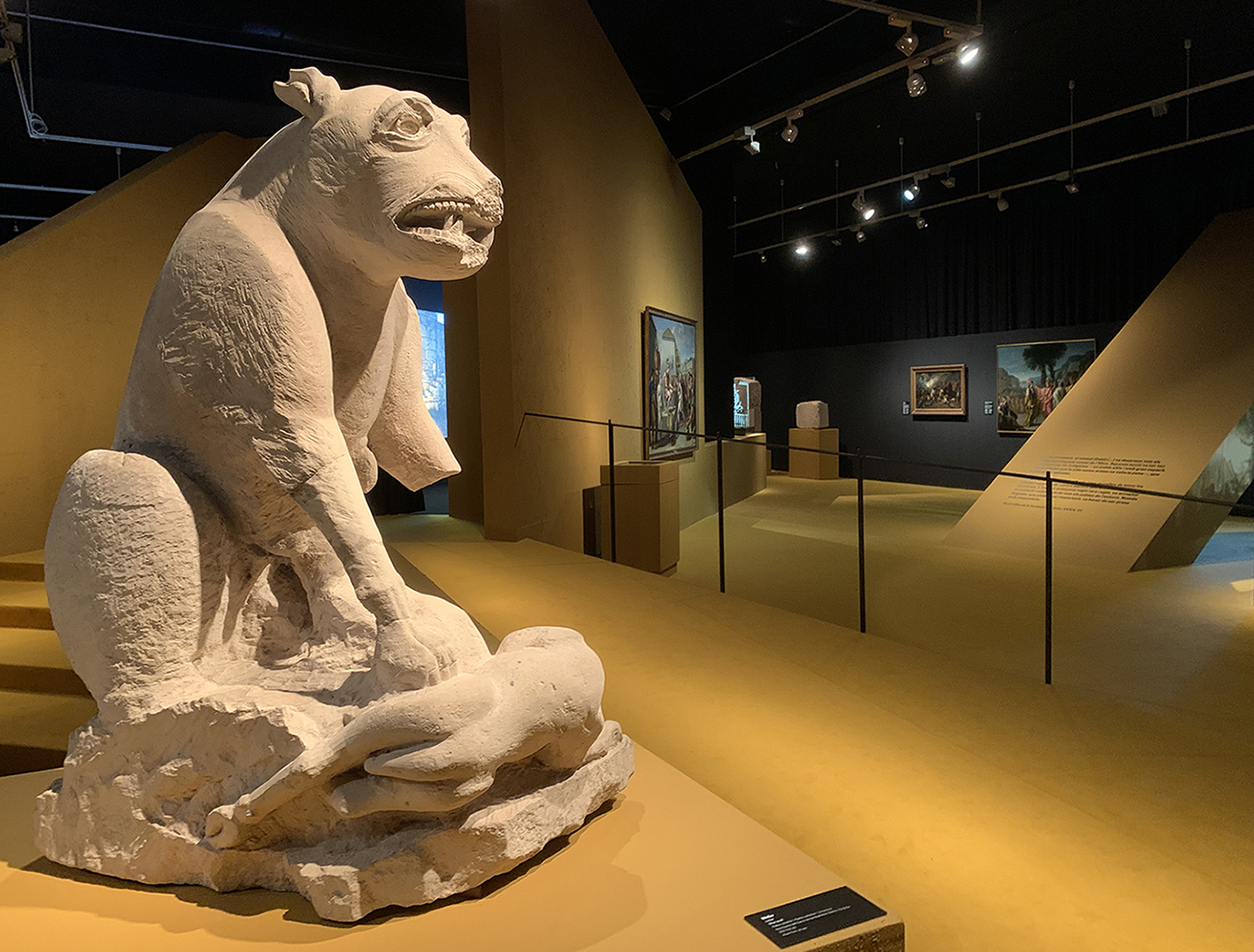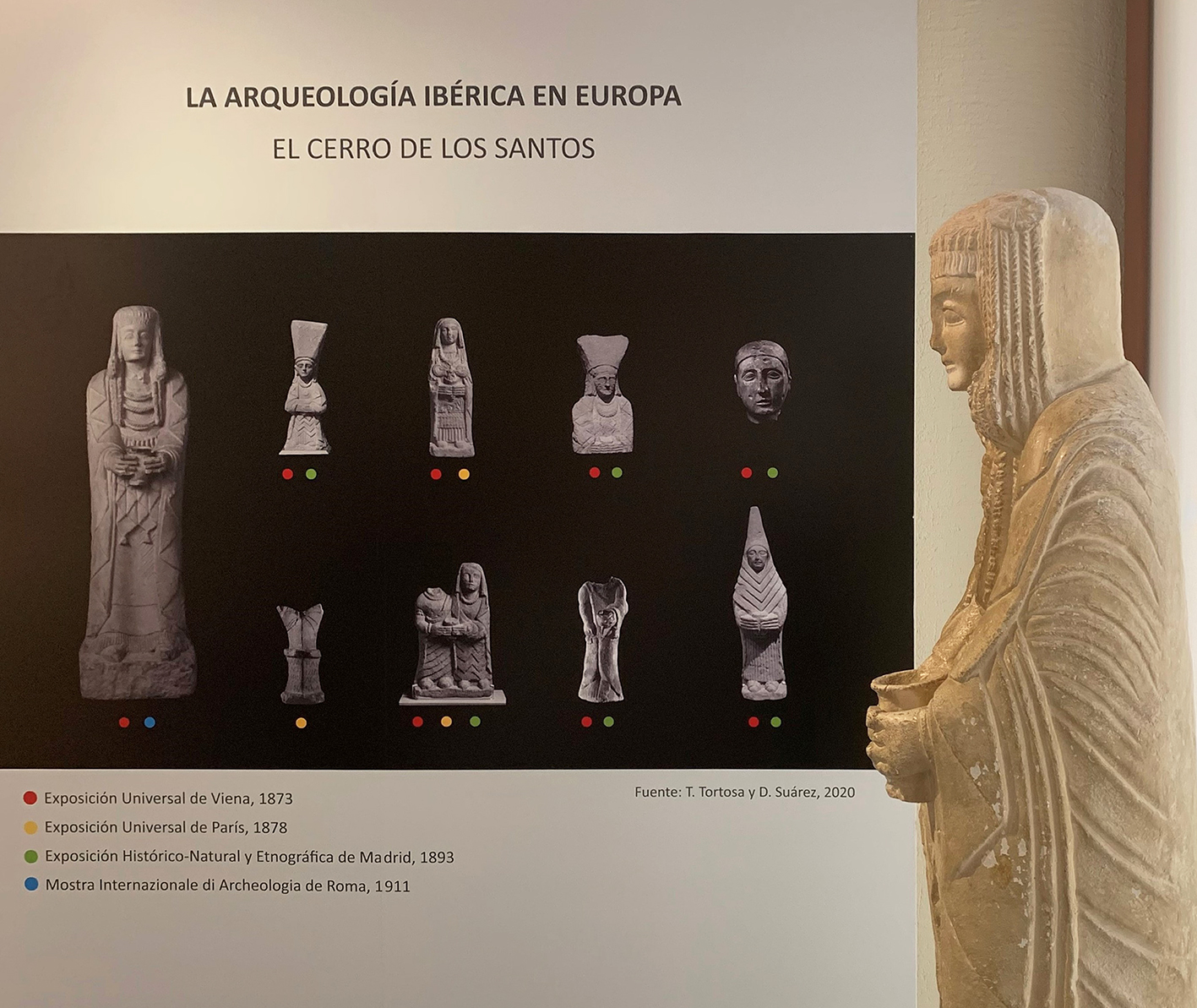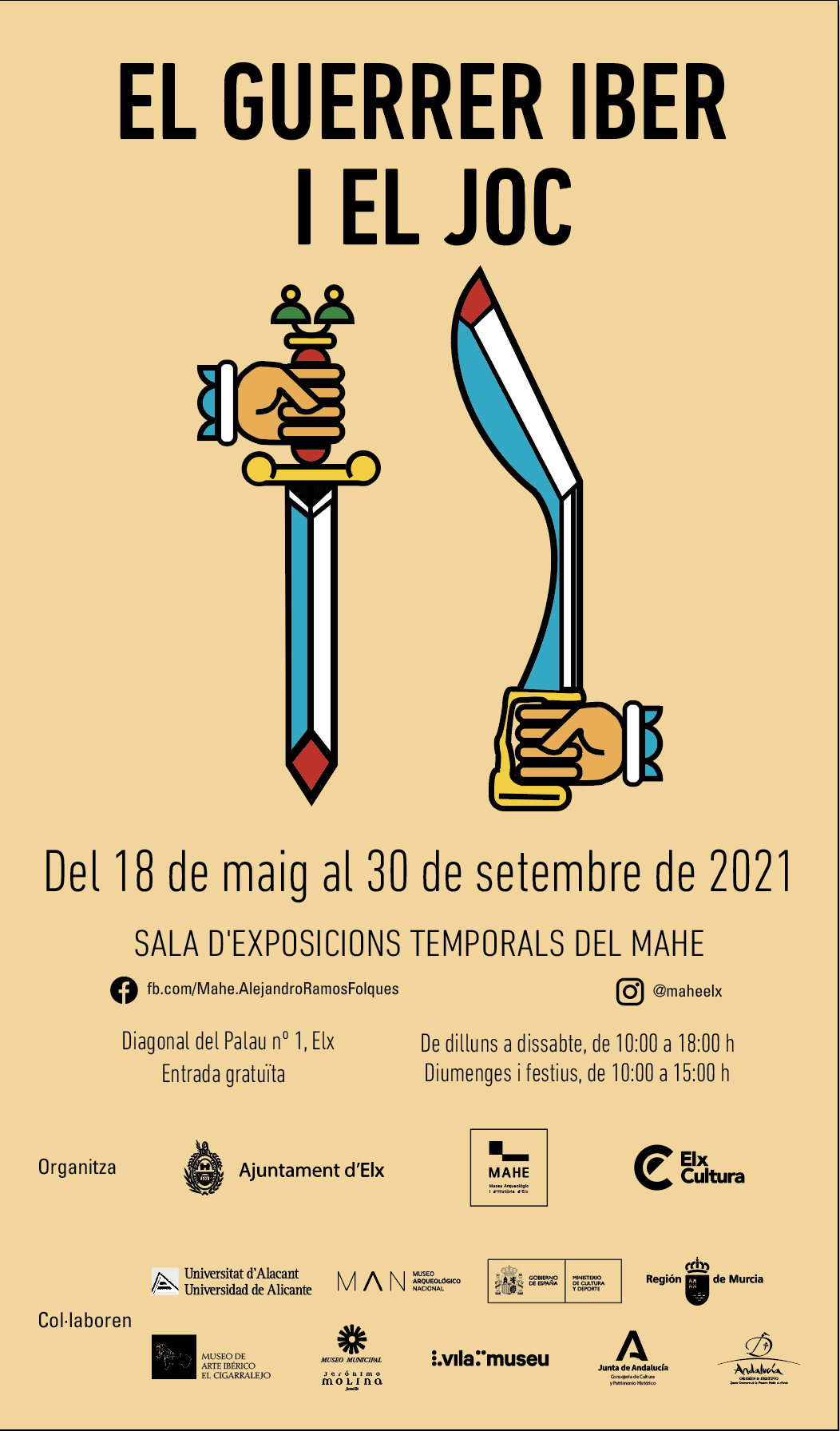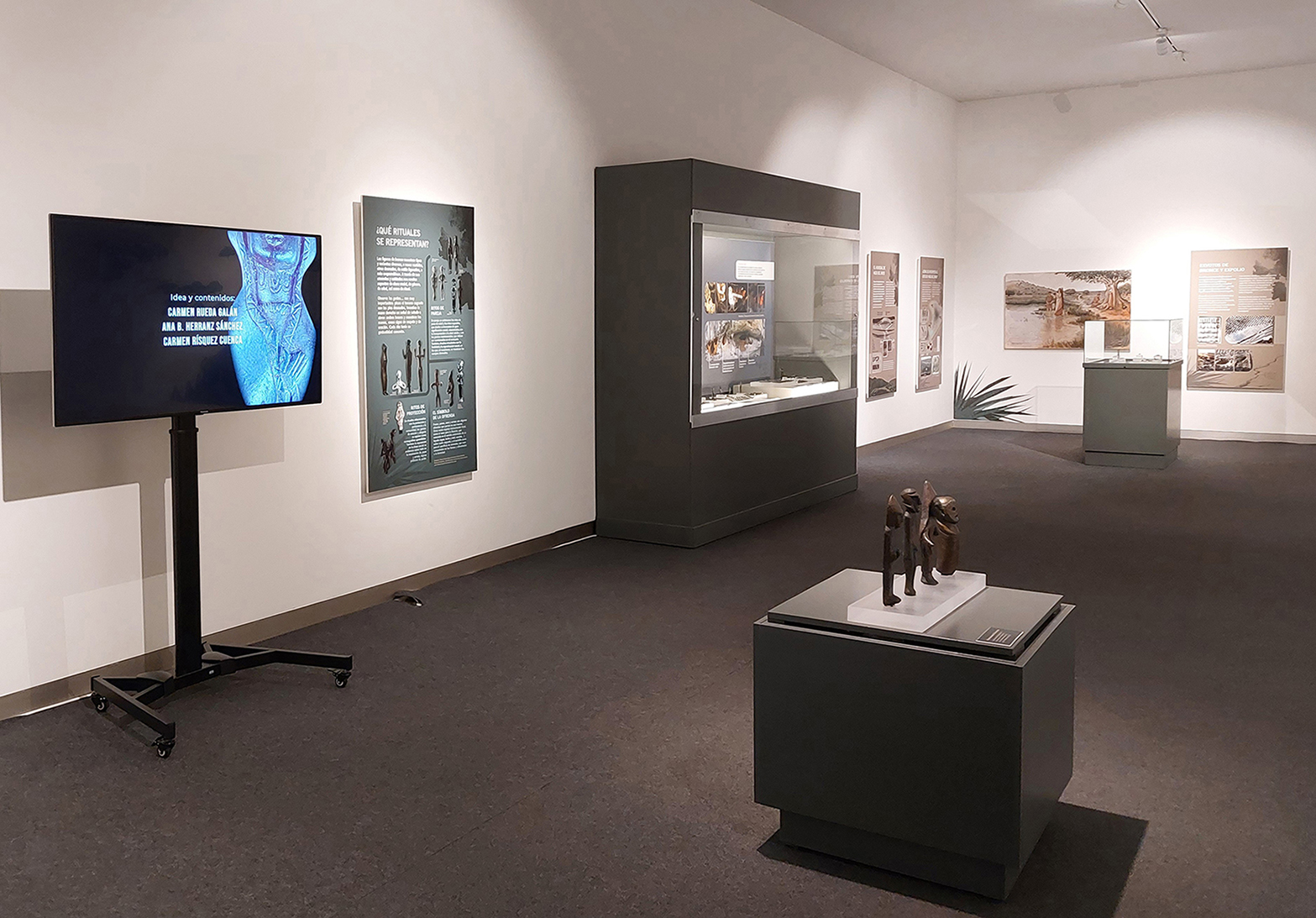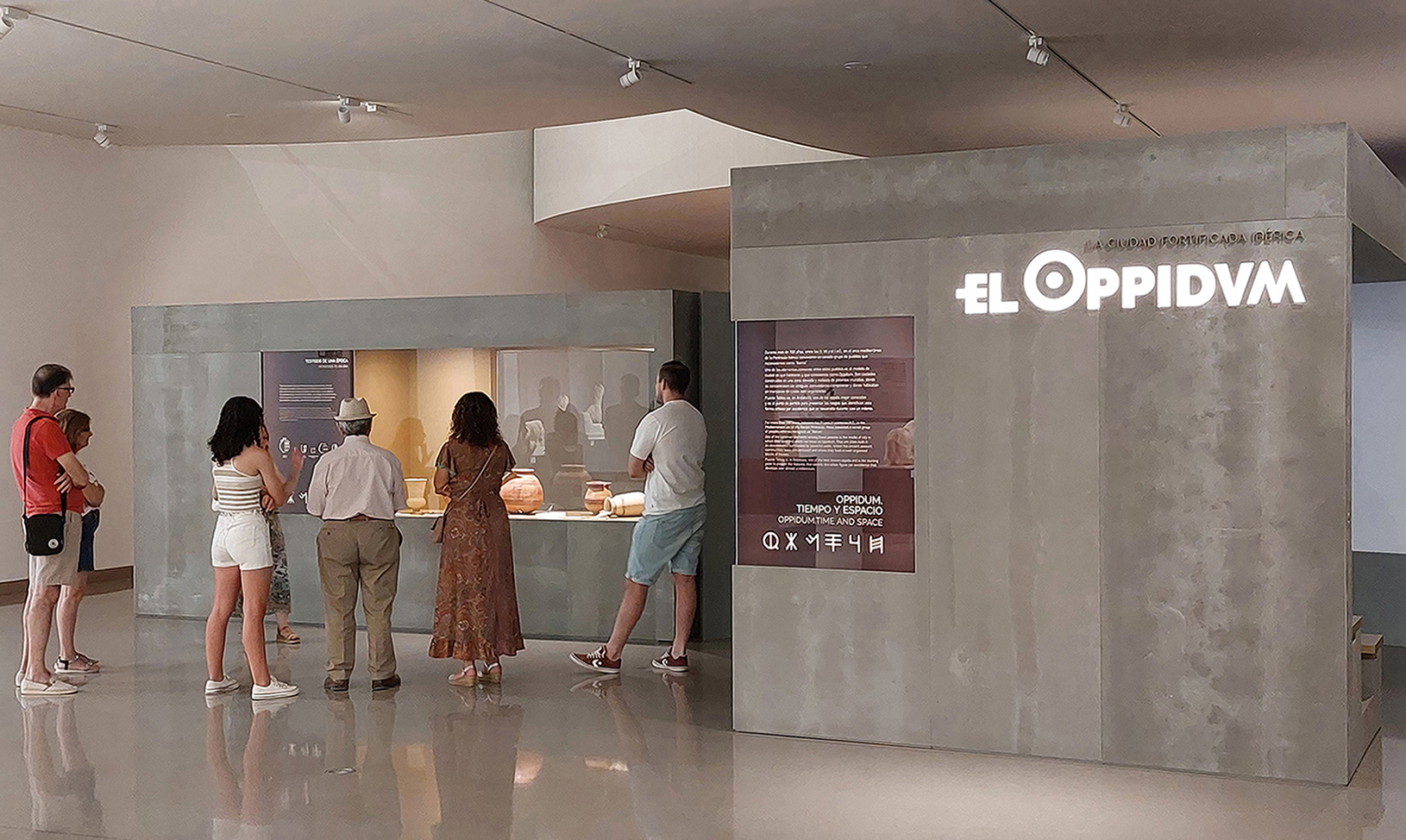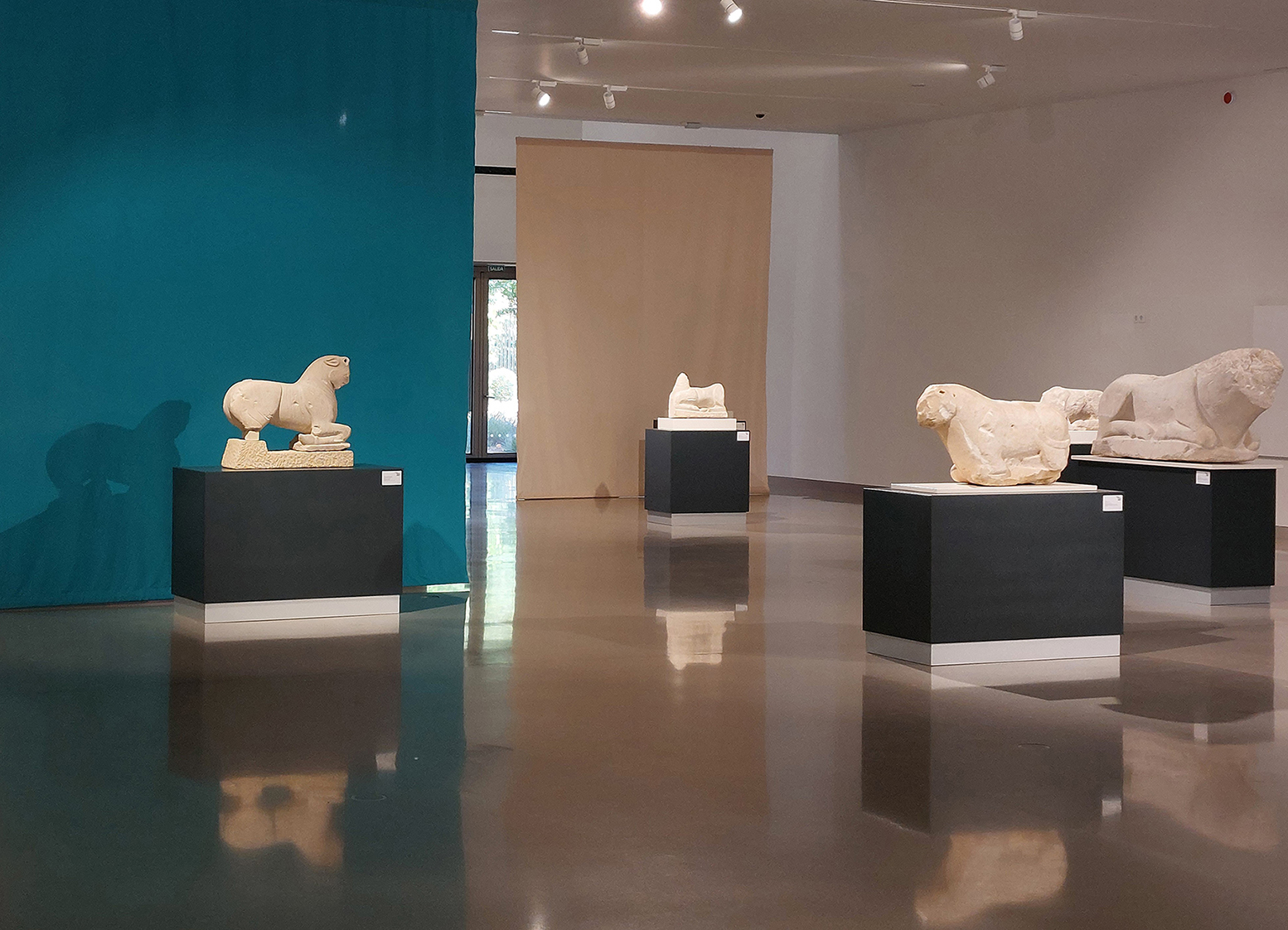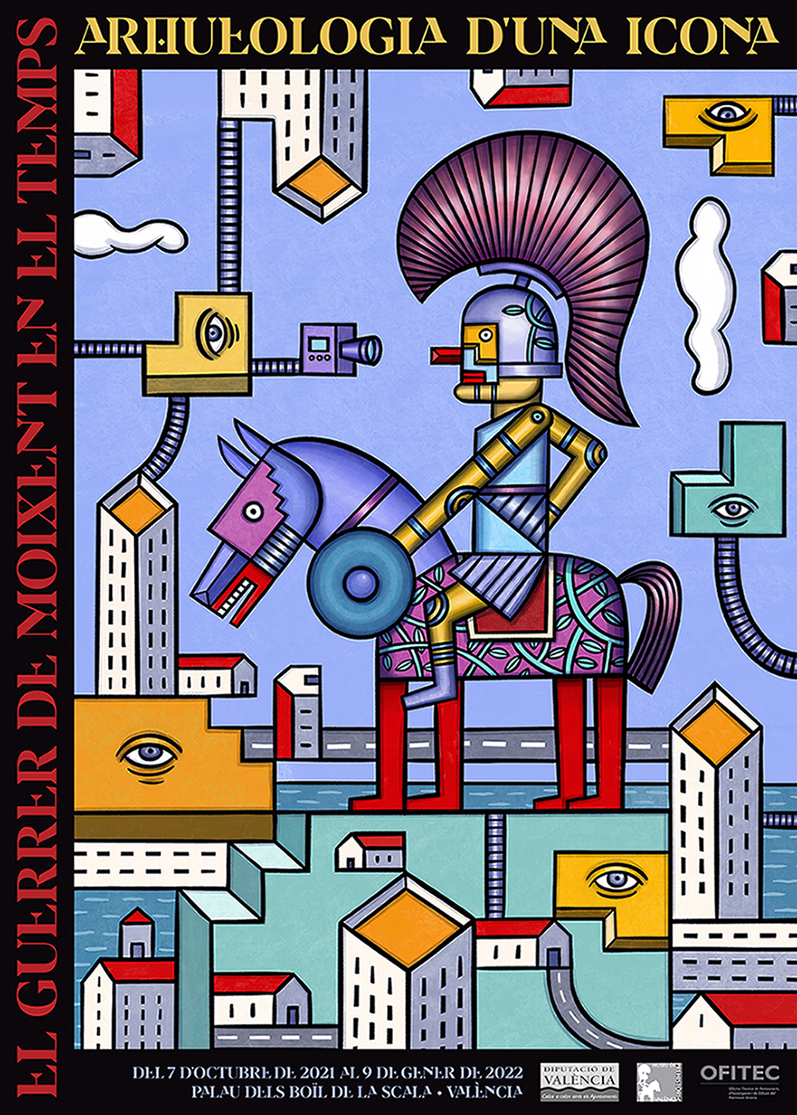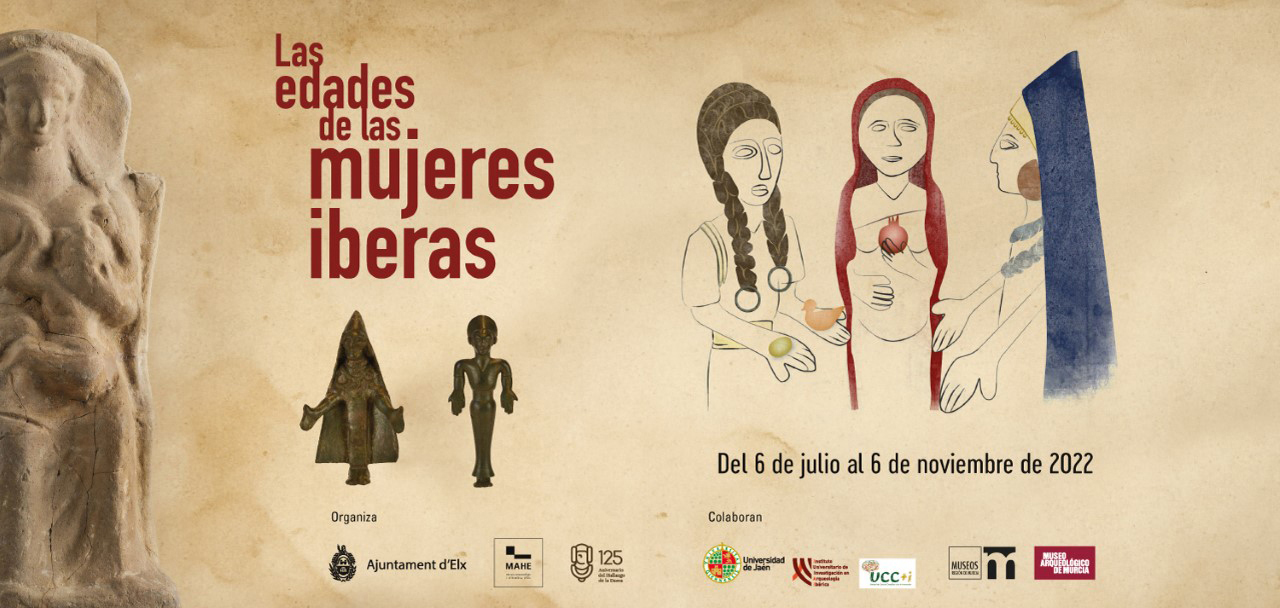Recent times have been unusual from many points of view, including from a cultural perspective. After the global catastrophe caused by the Covid-19 pandemic, which broke out in late-2019, we needed to get back on our feet. As the limitations in the organization of events were left behind, public, and private museological institutions have been striving to return to normality and recover their face-to-face cultural offer. In this context, we were commissioned to curate a temporary exhibition dedicated to the Iberian world that would be inaugurated in 2021 at the central headquarters of the Archaeological Museum of Catalonia (MAC) in Barcelona. While we were preparing the exhibition, we realized that, in a short time, several exhibitions dedicated to the same theme would be simultaneously open to the public in Spain. Furthermore, in parallel, the anniversaries related to the discovery of Iberian art and key moments in the history of Iberian archaeology would follow. The Iberians would return to the front pages with force. In this article, we analyze the main exhibiting experiences inaugurated during 2021, which in some cases last until 2022.
2. Exhibitions “Iberian Picasso” (Botín Center, Santander)Among the various temporary initiatives that we discuss, the Botín Center in Santander was the first one to open and the most unique, since it brought together the work of one of the best artists of the 20th century, Pablo Picasso, with pieces from the Iberian culture from more than two thousand years earlier.
Organized by the Botín Center, Banco de Santander, and the Musée National Picasso-Paris, with Cécile Godefroy as curator and Roberto Ontañón as associate curator, it was open between 1 May and 12 September 2021. It occupied around 1,300 square meters and was visited by 65,644 people.(1)
The meeting point between Picasso and archeology are two stone busts from the Cerro de los Santos sanctuary which are preserved in Paris. Picasso came into contact with Iberian art through the Musée du Louvre in 1906, when an exhibition was organized there with sculptures from Cerro de los Santos (Albacete) and Osuna (Seville). A good Iberian collection had gone to the museum, in which the most outstanding pieces were the Lady of Elche (acquired in 1897) and the small votive offerings, which were quite a cultural novelty at the time.
The aim of the curators was to show how this “discovery” impacted Picasso, influenced his creative process, and transformed his work, giving way to a deep formal study that led him to cubism. We should not forget that two of the Cerro de los Santos heads—which had been stolen from the Musée du Louvre—were kept by the artist at his home for a couple of years.
The focus was therefore on Picasso, who was the guiding thread of the display and the element of attraction for the public in a large-format exhibition that traced his entire trajectory, and where the art of the Iberians would appear as a reference that inspired him in some formal approaches and in the use of new materials. An example of this is the bronze votive offerings—Picasso managed to acquire ninety-five of them for his collection.
The diaphanous, open exhibition space, which is an advantage offered by the modern building designed by the architect Renzo Piano, was adapted to a sober and at the same time forceful museography, with volumes and showcases that separated and shaped its different areas, essentially playing with two colors—white and dark gray—and where the light and dark tones of its sections created a clean atmosphere that allowed attention to be focused on the pieces.
The first of the three areas of the exhibition was dedicated to the presentation of Iberian culture through a selection of high-quality sculptural pieces, while in the second and third areas the narrative focused on the influence of Iberian art on Picasso. The second area covered the artist’s cubist period (1906-1908), while the last one reviewed his long relationship with human figures such as those of votive offerings, an inspiration that surfaced periodically in the creative life of the genius.
213 works were exhibited (including three books). The Iberian ones (93) were on a par with those by Picasso (117) and entered an interesting dialogue of mirrored play with them. Among the former were sculptures in stone and bronze or ceramic vessels, which are quite central in the Iberian world, and were accompanied by the essential data to orientate the visitor. However, their dialogue with Picasso’s pieces sometimes felt a bit forced, until it disappeared towards the end of the tour. Such exceptional pieces as the Alcorisa calathus of the plow, the Carmona “pithos” of the gryphons or the Goddess of Libisosa had their place in the exhibition, but with no other intention than that of being displayed.
A significant number of private collectors, organizations and around twenty museums—such as the National Archeology Museum (Madrid), the Musée du Louvre (Paris), the Provincial Museum of Jaén, the Albacete Provincial Museum, the Archaeological Museum of Alicante (MARQ) or the Prehistory Museum of Valencia—lent assets for this exhibition. The contributions of the Musée National Picasso (Paris) and the Almines and Bernard Ruiz-Picasso Foundation deserve separate praise. The exhibition’s catalog, dressed in careful graphic design, collects them all, alongside short introductory texts written by specialists. It was co-edited by the Botín and La Fábrica Foundation under the scientific direction of Cécile Godefroy, Hélène Le Meaux and Pierre Rouillard.
“The Iberian Enigma. The Archeology of a Civilization” (Archaeological Museum of Catalonia, Barcelona)At the headquarters of the Archaeological Museum of Catalonia (MAC) in Barcelona it was possible to see between 28 May 2021 and 16 January 2022—with a great reception in the media and good response from the public—another extensive exhibition of in-house production (950 square meters) dedicated to Iberian culture: “The Iberian Enigma. The Archeology of a Civilization,” curated by David Asensio, Núria Molist, Gabriel de Prado and Carme Rovira.
Almost twenty-five years after the famous “The Iberians. Princes of the West” project (Paris-Barcelona-Bonn), which was promoted by the “La Caixa” Foundation together with the Spanish, French and German governments to publicize this culture on a large scale (Aranegui, 1998), it was fully justified for the MAC—which is the museum managing the main Iberian legacy, both movable and immovable, in Catalonia (Boya, 2021) and is a reference for the whole country—to promote a project capable of providing a global, up-to-date perspective on the Iberian world based on the novelties that research keeps providing incessantly, which are mostly the result of the action of its very own teams (Asensio et al., 2021).
To achieve this, one should start from a narrative that is rigorous from a scientific point of view but also attractive enough for all kinds of audiences. It ended up being structured dually: with a main circuit made up of seven thematic areas—“The Search for the Iberians,” “The Iberian Mosaic,” “The First Iberians,” “The Time of the Princes,” “Inside Iberia,” “Between Rome and Carthage” and “The End of a World”—which located Iberian culture in space and time and showed its main identity features and economic and social structure, as well as its involvement in the Second Punic War and the Romanization, alternated with a parallel circuit made up of seven zoom-ins on current research challenges, the so-called “enigmas,” which made the exhibition unique and gave it its name. A section on the Route of the Iberians in Catalonia and the socialization of heritage was also added.
The capsules of the “enigmas” had a different formal treatment and were dedicated to the origins of the population through genetics, their indecipherable writing system, their blurred religious pantheon, their funerary manifestations, the little-known Iberian Barcelona, and the trace of Hannibal in Catalonia. At a museographic level, the capsules started with a question and focused attention on an archaeologist specializing in each subject, who synthesized their answer through a video.
The exhibition brought together nearly five hundred objects, including emblematic archaeological pieces and others previously unpublished, historicist paintings, books, and facsimiles. Its archaeological section covers pieces from the entire ancient Iberian territory (present-day Andalusia, Murcia, Valencia, Aragon, Catalonia and Languedoc) from all the way back to the 6th century and until the 1st century BC, thanks to a wide selection of MAC collections from the Barcelona, Empúries, Girona, Olèrdola and Ullastret headquarters and to multiple loans from 38 Catalan, Spanish and international institutions.(2) Next to a wide ceramic repertoire, the numerous epigraphic evidence stood out, which are part of one of the best series of bronze votive offerings from the sanctuaries of the south-east of the Iberian peninsula, iconic sculptures such as the “Warrior’s Torso” from La Alcudia in Elche, the “Warrior Spearing the Enemy” from the necropolis of El Cerrillo Blanco in Porcuna or the “Pillar-stela of the Horsemen” from Coimbra del Barranco Ancho in Jumilla, busts from the sanctuary of Cerro de los Santos, the shocking “severed heads” from El Puig Castellar and Ullastret, as well as the Treasure of Tivissa.
In addition to these emblematic works, the production stood out for an innovative museography by the Pigem/Matamala studio, complemented with Marta Carreté’s graphism, and a powerful audiovisual component mostly produced for the occasion consisting of a dozen products in various formats, different mappings projected onto stelae, an immersive room dedicated to the Iberian settlement of Ullastret and the digital reconstruction of the funeral monument of Cal Posastre (https://www.youtube.com/watch?v=7t69jJK1dWk ).
All of this made the most up-to-date knowledge about Iberian culture, with all its diversity, available to all audiences under a new perspective and demonstrating that research is progressing and giving rise to a lively debate. To leave proof of this, a trilingual catalog was also published (in Catalan, Spanish and English, as the entire exhibition) with texts by specialists and a selection of pieces. The broad program of activities carried out consisted fundamentally of guided tours and conferences. Visitors (nearly 25,000) also had an audio guide accessible via QR codes. http://www.macbarcelona.cat/Exposicions/Historic-exposicions/2021/L-Enigma-Iber.-Arqueologia-d-una-civilitzacio.
“150 years with the Iberians. 1871-2021” (Albacete Provincial Museum)The exhibition on the Iberians at the Albacete Provincial Museum was promoted by the Regional Government of Castile-La Mancha, the Ministry of Education, Culture and Sports, with the collaboration of the Albacete Provincial Council, the Friends of the Albacete Museum Association, Globalcaja de Albacete Foundation and El Corte Inglés. Curated by Rubí Sanz, Lorenzo Abad and Blanca Gamo, it was open to the public from 28 November 2021 to 27 March 2022.
The Albacete Provincial Museum has a collection from the Iberian period of a very high quality, with prominent pieces that come from such important sites as the sanctuary of Cerro de los Santos, the necropolises of Los Villares de Camino de la Cruz or El Toril, or the settlements of El Amarejo, Tolmo de Minateda or la Quéjola. It is precisely Cerro de los Santos, one of the first sites where Iberian culture was identified in 1871, what triggered this exhibition, since it is associated with the commemoration of the 150th anniversary of the edition of the book Memoria de las notables excavaciones hechas in Cerro de los Santos, by the priest Carlos Lasalde.
The statuary and other objects from this sanctuary were key to materializing Iberian culture, as well as classical sources and numismatics.
This exhibition was organized in eight areas that made up two large blocks. The first one had two areas. It was dedicated to the significance, assessment, and contextualization of Cerro de los Santos and its contribution to peninsular protohistory at the end of the 19th century, still at an early stage in the archaeological discipline. In the second block, which occupied most of the space and was deployed in six areas, the main focus was given to the presentation of the Iberians of the Murcia area and its surroundings.
At a museographic level, these two blocks were resolved differently: in the first one the weight of the narrative rested on the graphic and textual information recovered from archives and old publications, supplemented with some pieces from Cerro and a reproduction of the Lady of Elche, and the second block the pieces focused on the visitor’s attention. It is worth noting that some objects are exceptional, especially the ceramic vessels, with a formal and decorative repertoire characteristic of the Iberian peoples known as the Contestans, the Bastetans and the Oretans.
The exhibiting space conditioned the design and the route of the display, which was austere. Individual showcases and a few panels alternated, with a common narrative that was difficult to grasp, since the different environments were not clearly set apart. At the same time, the digital means were limited to the projection of lectures by renowned specialists in the Iberian world. The curators, rather than providing a large volume of information, opted for visual simplification, where the visitor was challenged to compare and play with the coroplasty and iconography. Following this path, some didactic elements were proposed that facilitated the understanding of some of the displayed objects.
In short, this was a relevant exhibition for the promotion of Cerro de los Santos and the discovery of Iberian culture, as well as for the archaeological wealth of this area of the Iberian Peninsula, which has been complemented by a cycle of twelve lectures by first-level Iberian scholars and an extensive catalog that includes nearly sixty articles to delve into a multitude of topics related to the initial research on the Iberians and the impact on the knowledge of their territory, society, habitat, religiosity, necropolises, and so on. It is accessible on the Internet and there is also the possibility of carrying out a virtual visit to the exhibition by downloading the didactic materials and accessing an online image gallery (https://cultura.castillalamancha.es/museos/exposiciones-temporales/150-anos-con-los-iberos-1871-2021).
“The Iberian Warrior and Games” (Alejandro Ramos Folqués Archaeology and History Museum of Elche - MAHE)“The Iberian Warrior and Games” was open to the public since 18 May to 30 September 2021. The informative and playful approach of this 285 square meter production, with a hundred pieces provided by six entities (the organizing museum, the National Archaeological Museum, the Linares Archaeological Museum, the Vilamuseu - Municipal Archaeological Museum of Vila Joiosa, the Jerónimo Molina Archaeological Museum in Jumilla and the El Cigarralejo Iberian Arts Museum), made it the most frequented exhibition (7,507 visitors) of the last ten years at the MAHE.
Its curators, Raimon Graells and Miguel F. Pérez Blasco, wanted to emphasize the practice of strategy and chance games among the Iberian warrior elites, but also to analyze this subject in the classical world and trace the parallels in the cultures of the Iron Age such as the Etruscans or the Celts. Each of these themes is assigned to an area, while the fourth and last one corresponds to romanization and transformations, which also come into play when they are no longer restricted to warriors.
Little evidence on the games closely associated with male identity and the Iberian military segments remains (tokens, astragalus and dice), such as those that ended up forming part of some outstanding funerary ensembles in the south-east of the peninsula, in the necropolises of the Poblado de Coimbra del Barranco Ancho (Jumilla) or El Cigarralejo (Mula), which are some of the main attractions of the exhibition.
This display was also materialized in a bilingual monograph (Spanish and Valencian): “El guerrer iber i el joc. Estratègia, atzar i estatus,” which follows its plot structure and brings together thirteen articles written by specialists in 127 pages. In addition, the interventions of the researchers who participated in the streaming scientific seminar “Warriors at Play” are to be found online (https://www.youtube.com/channel/UCMjmEIbwvhgIxLDu9CIMiLw), so that all this knowledge gathered in the exhibition can last.
“Iberian Votive Offerings. Sacred Landscapes, Pilgrimages and Rites” (Iberian Museum, Jaén)The organization of this exhibition was carried out by the University of Jaén (UJA) and the Ministry of Culture and Historical Heritage of the Government of Andalucía. The following entities participated in the conception and development of the exhibition: on behalf of the University of Jaén, the Vice-Rectorate for the Promotion of Culture and Sport, the Iberian Archeology Institute, the Scientific Culture Unit, and the Research Group of the Archaeological Heritage of Jaén (GIPAJ); the National Archaeological Museum; the Ministry of Development; and the collaborative project Pastwoman.
The exhibition and its catalog—curated and coordinated by Carmen Rueda, Ana B. Herranz and Juan P. Bellón—were dedicated to the memory of Pilar Palazón, a key figure in the dissemination of the Iberian culture of Jaén through the foundation in 1998 of the Friends of the Iberians Association, over which she presided until her death in April 2020. From this platform, she fought tirelessly for many years for the creation in Jaén of a large museum dedicated to Iberian culture, which was inaugurated in 2017, albeit incompletely.
The display had two exhibiting spaces in the city of Jaén placed very close to each other. The larger one was on the first floor of the Iberian Museum—which occupied an area of around 100 square meters—and the other, of smaller dimensions, was in the “Obra Invitada” space at the Ancient Teaching School (University of Jaén, UJA), of about 25 square meters. It was inaugurated on 18 May 2021, coinciding with International Museum Day, and was extended through 2022.
At the Iberian Museum, the main nucleus of the exhibition can be visited. It was conceived with the aim of presenting the results of the most current archaeological research, which is developed by the entities of the organization. It focused on the study of ritual landscapes, pilgrimages and the materials involved in worship. In this sense, it is particularly relevant for the novelties provided by the recent discovery and study of the sanctuary of Haza del Rayo (Sabiote, Jaén) in the context of the landscape and the political territory of the Iberian city of Cástulo (Linares, Jáen).
Regarding the museography, the exhibition is located in a single room, with the main information arranged on panels distributed linearly. It is structured in two areas that are differentiated by the background colors of their panels. The first area, which could be considered an introductory one, explains, among other issues, the world view that Iberian societies could have had, what bronze votive offerings are, and what rituals they represent. Likewise, the ritual landscape surrounding the city of Cástulo and the types of sanctuaries in the territory are defined. The second area focuses on showing the results of the multidisciplinary research linked to the sanctuary of Haza del Rayo, which has been an exceptional discovery in characterizing a new typology of cultural and symbolic space that accentuates the complexity that was already intuited in the distribution of the ritual landscape around the city of Cástulo.
Finally, it should be noted that a hardcover catalog of a very high scientific quality, coordinated and edited by the curators of the exhibition themselves, presents a collection of articles that expand its contents. Also, as a complement, at the Ancient Teaching School (UJA) a small selection of bronze votive offerings from the extensive collection of the National Archaeological Museum has also been presented.
“The Iberian Fortified City: The Oppidum” (Iberian Museum, Jaén)This display, inaugurated on 29 December 2021, is still located in the ground floor exhibition hall of the Iberian Museum. It occupies an area of 425 square meters and is conceived as a first phase or anticipation of the assembly of a future permanent exhibition. For this reason, it has been curated by Concepción Choclán, director of the museum. Its main goal is to explain the Iberian culture from the fortified town (known as Oppidum in the Latin field), which can be considered the nuclear unit of this culture, and, from there, to develop everything that orbits around this central urban space.
The display is a semi-permanent installation where 552 objects from the Iberian Museum’s collection are exhibited, corresponding exclusively to the fund of the Government of Andalucía. Most of these objects come from actions carried out in some of the numerous archaeological sites of this period that are known in the province of Jaén: Puente Tablas (Jaén), Giribaile (Vilches), Los Turruñuelos-Baécula (Santo Tomé), and so on.
The proposal is structured in six areas, presented through an effective and contemporary museography by J.P. Rodríguez Frade and Vélera Diseño, preceded by an introductory space where the Oppidum is located and contextualized in space and time, as well as the Iberian culture itself. A video designed for small groups or families and projected on a large, curved screen also stands out.
This presentation precedes the first two sections, “Primitive Villages, Remote Times” and “The Construction of the Oppidum,” which outline and define, respectively, the period immediately preceding the development of Iberian culture and the process of changes that precipitated the appearance of fortified habitats. The third section, “Sacralization of the Oppidum and its Territory,” explores religiosity and the ritualistic sphere through the urban sanctuaries and the sacred spaces outside the walls existing in the territory. The following one, “The Urban Space of the Oppidum,” presents the unity of the habitat exemplified by the house as a home but also as a place of work, as well as the palace understood as a residence of the prince or chieftain, while in another area entitled “Beyond the Oppidum” we get closer to the reality of the exploitation and control of the territory of the Oppida, where necropolises, understood in this case as “residences” of the ancestors, also have their place.
The last section, “New Times: Carthage and Rome,” addresses the upheaval caused by the Second Punic War and the consequences of the Carthaginian defeat, with the dissolution of Iberian culture and the implementation of Roman civilization in Hispania. The Battle of Baecula, a war episode that took place in 208 BC, plays a relevant role, the investigation of which has become a model for approaching these types of studies. Finally, and as an addendum, there is a panel that values scientific research as a source of knowledge of the history of the Iberians.
The exhibition catalog, edited by Concepción Choclán, is a compilation of articles written by first-level researchers linked, for the most part, to the Iberian Archaeology Research Institute of the University of Jaén. Topics directly related to the object of the exhibition or derived from it are addressed using a language and a composition of high dissemination. At the end of the book, there is a general bibliography and the catalog of every single piece, in some cases grouped by type or provenance.
“The Iberian Fortified City: the Oppidum.” Iberian Museum in Jaén. Introductory space of the display. Image: authorsThis proposal, located in a part of the hall of the Iberian Museum (occupying an area of about 250 m²) and developed in collaboration with the Archaeological and Ethnological Museum of Córdoba and the Jaén Museum, constitutes a kind of anteroom of the exhibition “The Iberian Fortified City: The Oppidum,” materially, symbolically and conceptually speaking. It was curated by Concepción Choclán too and opened at the same time as her other exhibition on 29 December 2021.
This display revolves around the theme of the presence of zoomorphic sculptural figures in necropolises, which, in turn, constitute elements of a strong symbolic presence in the territorial landscape of the Oppida.
Thus, with an extremely simple scenography, there is a selection of twelve works from the aforementioned organizing museums, with the representation of three bulls, six lions, two deer and a herbivore, which are distributed throughout the space.
In the scarce and concise associated texts, the fact that we currently see these sculptures stripped of their original polychromy is highlighted, although we are certain that in their original context, they presented an extraordinary diversity of color that must have impacted those who contemplated them.
“Archeology of an Icon. The Moixent Warrior in Time” (Valencia Provincial Council)The Marqués de la Scala Palace, headquarters of the Valencia Provincial Council, was the space that hosted the exhibition organized by the Technical Office of Restoration, Research and Diffusion of Artistic Heritage of the Prehistory Museum of Valencia, dedicated to the iconic Moixent Warrior. Curated by Jaime Vives-Ferrándiz, it was open from 7 October 2021 to 9 January 2022, and received 5,786 visitors. This seven-centimeter-tall horseman made in bronze was found in July 1931 in the Iberian village of Bastida de les Alcusses (Moixent, Valencia), one of the most prominent Iberian peninsular settlements.
Ninety years later, the small bronze figure has become an emblem of the Levantine Iberian world. Different aspects around the figure were reviewed throughout three spaces.
The first one served as an introduction. It had a large panel with a life-size drawing of the warrior that welcomed and contextualized the historical moment of the discovery and systematization of Iberian culture, symbolized by a replica of the Lady of Elche made by the Valencian sculptor Ignasi Pinazo in 1908 at the Musée du Louvre.
The excavations at the Bastida de les Alcusses and the appearance of the figurine occupied the next room, as well as other pieces of the archaeological interventions carried out by the Prehistory Museum of Valencia between the years 1928 and 1931, framed by powerful archive images.
The third room hosted the main block of the exhibition, with the display of the original piece—and highlighting such a small piece is quite a design challenge. With the object and the panel that framed it, attention was focused on different technical, formal, social and iconographic aspects of the figure, such as the metallurgical process of making the object, its formal details—such as its helmet with a large plume—, the horse’s harness or its set of offensive and defensive weapons, the representation and the significance of its knight and his panoply in society and its embodiment in Iberian art and ceramics.
The tour concluded with the area dedicated to the configuration of the icon from the 1970’s and its uses and appropriations by the Valencian society, which show the interrelationship between the past and the present. The Moixent Warrior has become the logo of the Prehistory Museum of Valencia, a monument at the Valencian Falles and the symbol of the town of Moixent itself. In the last area of the exhibition, it was approached through didactic elements reinforced by four interactive audiovisuals designed for schoolchildren and family audiences.
In short, it was a small exhibition of about 250 square meters very well resolved, effective in terms of museography, as it consisted of large panels and abundant graphic images of important proportions and few pieces (44), only the essential ones to provide a counterpoint to the central one, the Moixent Warrior. The design was undertaken by MacDiego, but the colorful poster by Cento Yuste is also worth noting. It perfectly exemplifies the translation to the present of a 2,400-year-old image.
Between 28 June and 25 September 2022, an adaptation of the installation could be seen in the town of Moixent, and its catalog, authored by Jaime Vives-Ferrándiz, Laura Fortea and Eva Ripollès, was presented at the Prehistory Museum of Valencia.
“The Ages of Iberian Women” (Alejandro Ramos Folqués Archaeology and History Museum of Elche - MAHE)The MAHE wanted to join the commemorations for the discovery of the Lady of Elche between 6 July and 6 November 2022 with an adaptation of “The Ages of Iberian Women,” which began touring in the year 2016 thanks to the collaboration between the Iberian Archaeology Research Institute of the University of Jaén and the Jaén Museum.
It was curated by researchers Carmen Rísquez, Carmen Rueda, Ana B. Herranz, Francisca Hornos and Antonia García, specialists in archeology with a gender perspective. They created this display as part of a research project with the aim of radically disseminating Iberian archeology from the perspective of women.
The content unravels the phases of the female life cycle: from childhood and puberty to adulthood and death, focusing on women’s active relationship with sacredness and rituality. It analyzes both its image at each stage and the processes of political legitimation inferred from the study of sanctuaries and funerary contexts. The high-ranking female figure receives special attention, based on votive offerings and its two best sculptural examples: the ladies of Baza and Elche. The historical context of the discovery of the latter—which is an emblem of Iberian culture—in Alcúdia in 1897 is explained in detail.
It is a formally austere proposal, with an important graphic component designed by María José López Tabernero and Ana B. Herranz, associated with archaeological pieces from the Archaeological Museum of Murcia and the MAHE itself. It also incorporates a reproduction of the Lady of Elche, given the impossibility of having the authentic one, preserved at the MAN in Madrid, and a creative audiovisual where several current women recall the ritual gestures of the female votive offerings located in the sanctuaries of the south-east of the peninsula. Among all proposed activities, the ones standing out are didactic workshops and guided and theatrical tours.
3. Final reflectionsMuseological institutions and cultural centers worldwide have been affected by the pandemic caused by the SARS-CoV-2 coronavirus since 2020. The recovery of a certain “normality” facilitated the return of face-to-face offers and the revival of temporary exhibitions such as those dedicated to archeology, which in Spain, between 2021 and 2022, have focused especially on Iberian culture.
Although still far from mass experiences like the one represented by “The Iberians. Princes of the West,” the Iberians have returned to the front pages with renewed appeal and diverse proposals both from the point of view of content and formalization. It is worth remembering that 2021 was also a year full of commemorations linked to the discovery of emblematic works: the 150th anniversary of the sculptures of the Cerro de los Santos sanctuary (Albacete), the 50th anniversary of the Lady of Baza (Cerro del Santuario, Granada), the 90th anniversary of the Moixent Warrior (Moixent, Valencia), or the 40th anniversary of the pillar-stela of the Barranco Ancho necropolis (Jumilla, Murcia). However, only the Albacete Provincial Museum and the Valencia Provincial Council decided to produce remarkable temporary exhibitions around their corresponding ephemerides. Meanwhile, the intention of the Elche City Council to celebrate the 125th anniversary of the appearance of their famous Lady in Alcúdia during 2022 had to be reconfigured in the midst of a strong controversy due to the impossibility of moving the original effigy from the MAN in Madrid.
Although all the presented displays focused on highlighting the importance of Iberian culture and its historical context in the second half of the first millennium BC, most did so essentially from a sectoral point of view—very interestingly too—like for example religiosity, games, war, or the artistic and sociological dimension. Only the MAC proposal addressed this extensively in a holistic way and not only based on certainties, but also emphasizing that Iberian culture is still not well known, and that unknowns do always stimulate research.
As a whole, the described proposals, regardless of their variables—dimensions (from 250 to 1,300 square meters), investment, museographic treatment, number of pieces included, duration, and so on—demonstrate the complexity of Iberian society and its heterogeneity, perhaps also because these are initiatives that have arisen mostly from museums and research groups from various areas of the ancient Iberian territory. The gender perspective was integrated into several narratives, and we would also like to highlight the interesting points of contact with the contemporary world highlighted in Santander and Valencia.
It should be noted that the good disposition of the museums that hold the main Iberian collections was decisive for the materialization of the aforementioned projects. Almost a hundred institutions agreed to collaborate with each other, transferring important works from their permanent collections and promoting other very interesting ones that usually remain in their reserves. The Musée du Louvre, the MAN, the MUPREVA, the MARQ, the Jaén Museum, the Iberian Museum, and the Murcia Museum have repeatedly contributed to this exchange, which made it possible to appreciate this heritage—which is usually found scattered far away between Spanish and French collections—from up close and in dialogue at different cities. The public, however versed on the matter, did appreciate the unique opportunity to have these ensembles within reach, to discover their details directly and to make a personal reading of them. The effort involved in moving these objects—and sometimes also expressly restoring them—results in an important financial endeavor for the promoting institutions, but it is fully justified because they succeeded in disseminating Iberian culture from new perspectives and on a large scale. Activities such as guided tours, workshops and online resources also contributed with their part.
As for the museographic aspect, all exhibitions show a good level of design and production, with very uneven investments according to the capacity of each organizing entity. This was more evident in the audiovisual section and especially in the most innovative technological resources, which—except for the MAC proposal, where these were prominent and achieved a special dimension—were scarce.
Finally, we would like to positively assess that these ephemeral but extraordinary experiences generated catalogs, teaching materials and other content, which can often be found online too, and that some, such as those in Jaén, included sections dedicated to pointing out the damage caused by the clandestine interventions that irreparably plunder our archaeological heritage and that, still today, continue to affect the legacy of Iberian culture.
Notes
We thank Begoña Guerrica-Echevarria and Manuel Diego for their contribution of information.
We thank Begoña Guerrica-Echevarria and Manuel Diego for their contribution of information.
Sant Martí Sarroca Town Council, Peralada Castle Museum, Camp de les Lloses Interpretation Center, Duran Vall-Llosera Collection, Valencia Provincial Council, Jaén Provincial Council, Catalan Private Foundation for Iberian Archeology, University Fundación La Alcudia, Jerónimo Molina Municipal Archaeological Museum (Jumilla), National Archaeological Museum, Archaeological Museum of Alicante (MARQ), Archaeological Museum of Murcia, Cigarralejo Museum of Iberian Art, Iberian Museum (Jaén), Jaén Museum, Archaeological Museum of Artesa de Lleida, Archaeological Museum of Vendrell, Municipal Archaeological Museum Camil Visedo Molto (Alcoi), Girona Art Museum, Sabadell History Museum, Granollers Museum, L’Escala Museums, Diocesan and County Museum of Solsona, Municipal Museum of Vila Joiosa - Vilamuseu, Lleida Museum, Prehistory Museum of Valencia, Terres de l’Ebre Museum, Ca n’Oliver Iberian Settlement and Museum, National Archaeological Museum of Tarragona, National Art Museum of Catalonia, Torre Balldovina Museum, San Fernando Royal Academy of Fine Arts, Directorate-General for Cultural Heritage - Government of Catalonia, Site archéologique et musée d’Ensérune - Centre des monuments nationaux (France), University of Barcelona.
Sant Martí Sarroca Town Council, Peralada Castle Museum, Camp de les Lloses Interpretation Center, Duran Vall-Llosera Collection, Valencia Provincial Council, Jaén Provincial Council, Catalan Private Foundation for Iberian Archeology, University Fundación La Alcudia, Jerónimo Molina Municipal Archaeological Museum (Jumilla), National Archaeological Museum, Archaeological Museum of Alicante (MARQ), Archaeological Museum of Murcia, Cigarralejo Museum of Iberian Art, Iberian Museum (Jaén), Jaén Museum, Archaeological Museum of Artesa de Lleida, Archaeological Museum of Vendrell, Municipal Archaeological Museum Camil Visedo Molto (Alcoi), Girona Art Museum, Sabadell History Museum, Granollers Museum, L’Escala Museums, Diocesan and County Museum of Solsona, Municipal Museum of Vila Joiosa - Vilamuseu, Lleida Museum, Prehistory Museum of Valencia, Terres de l’Ebre Museum, Ca n’Oliver Iberian Settlement and Museum, National Archaeological Museum of Tarragona, National Art Museum of Catalonia, Torre Balldovina Museum, San Fernando Royal Academy of Fine Arts, Directorate-General for Cultural Heritage - Government of Catalonia, Site archéologique et musée d’Ensérune - Centre des monuments nationaux (France), University of Barcelona.
Bibliography
Aranegui, C. (1998). “Propuestas, proyectos y negociaciones a favor de una gran exposición internacional de la cultura ibèrica”. Revista d’Arqueologia de Ponent 8, 178-180.
Asensio, D., Molist, N., Prado, G. de, Rovira, M. C. (2021). “L’enigma iber. Arqueologia d’una civilització. Una nova exposició, una visió renovada”. L’enigma iber. Arqueologia d’una civilització. Archaeological Museum of Catalonia, 15-20. (Catalog of the exhibition).
Baratta, G. (2021). “Il gioco in mostra: l’esposizione El guerrero íbero y el juego / El guerrer iber i el joc del MAHE di Elx / Elche”. Sylloge Epigraphica Barcinonensis (SEBarc) XIX, 309-310.
Boya, J. (2021). “Presentació”. L’enigma iber. Arqueologia d’una civilització. Archaeological Museum of Catalonia, 9-11. (Catalog of the exhibition).
Choclán, C. (coord.) (2021). La ciudad fortificada ibérica: el oppidum. Ministry of Culture and Historical Heritage, Government of Andalucía; Caja Rural Foundation. (Catalog of the exhibition).
Godefroy, C., Le Meaux, H., Rouillard, P., Ontañon, R. (directors) (2021). Picasso íbero. Botín Foundation. (Catalog of the exhibition).
Graells i Fabregat, R., Pérez Blasco, M. F. (ed.) (2021). El guerrer iber i el joc: estratègia, atzar i estatus. Elche City Council. (Catalog of the exhibition).
Rueda Galán, C., Herranz Sánchez, A. B., Bellón Ruiz, J. P. (coord.) (2021). Exvotos íberos. Paisajes sagrados, peregrinaciones y ritos. University of Jaén. (Catalog of the exhibition).
Sanz Gamo, R., Abad Casal, L., Gamo Parras, B. (coord.) (2021). 150 años con los íberos (1871-2021), Excma. Albacete Provincial Council. (Catalog of the exhibition).
Vives-Ferrándiz, J., Fortea, L., Ripollés, E. (2022). Arqueologia d’una icona. El Guerrer de Moixent en el temps. Prehistory Museum of Valencia. (Catalog of the exhibition).

 MNEMÒSINE REGISTRY
MNEMÒSINE REGISTRY 

